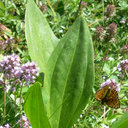Asplenioideae Species as a Reservoir of Volatile Organic Compounds with Potential Therapeutic Properties.
Paraules clau
Resum
Twelve French Asplenioideae ferns (genera Asplenium and subgenera Ceterach and Phyllitis) were investigated for the first time for volatile organic compounds (VOC) using GC-MS. Sixty-two VOC biosynthesized from the lipidic, shikimic, terpenic and carotenoid pathways were identified. Several VOC profiles can be highlighted from Asplenium jahandiezii and A. xalternifolium with exclusively lipidic derivatives to A. onopteris with an equal ratio of lipidic/shikimic compounds. Very few terpenes as caryophyllene derivatives were identified, but only in A. obovatum subsp. bilotii. The main odorous lipidic derivatives were (E)-2-decenal (waxy and fatty odor), nonanal (aldehydic and waxy odor with a fresh green nuance), (E)-2-heptenal (green odor with a fatty note) and 1-octen-3-ol (mushroom-like odor), reported for all species. A few VOC are present in several species in high content, i.e., 9-oxononanoic acid used as a precursor for biopolymers (19% in A. jahandiezii), 4-hydroxyacetophenone with a sweet and heavy floral odor (17.1% in A. onopteris), and 4-hydroxybenzoic acid used as a precursor in the synthesis of parabens (11.3% in A. foreziense). Most of the identified compounds have pharmacological activities, i.e., octanoic acid as antimicrobial, in particular against Salmonellas, with fatty and waxy odor (41.1% in A. petrarchae), tetradecanoic acid with trypanocidal activity (13.3% in A. obovatum subsp. bilotii), 4-hydroxybenzoic acid (8.7% in A. onopteris) with antimicrobial and anti-aging effects, 3,4-dihydroxybenzaldehyde as an inhibitor of growth of human cancer cells (6.7% in Ceterach officinarum), and phenylacetic acid with antifungal and antibacterial activities (5.8% in A. onopteris). Propionylfilicinic acid was identified in the twelve species. The broad spectrum of odorous and bioactive VOC identified from the Asplenium, Ceterach and Phyllitis species are indeed of great interest to the cosmetic and food industries.




